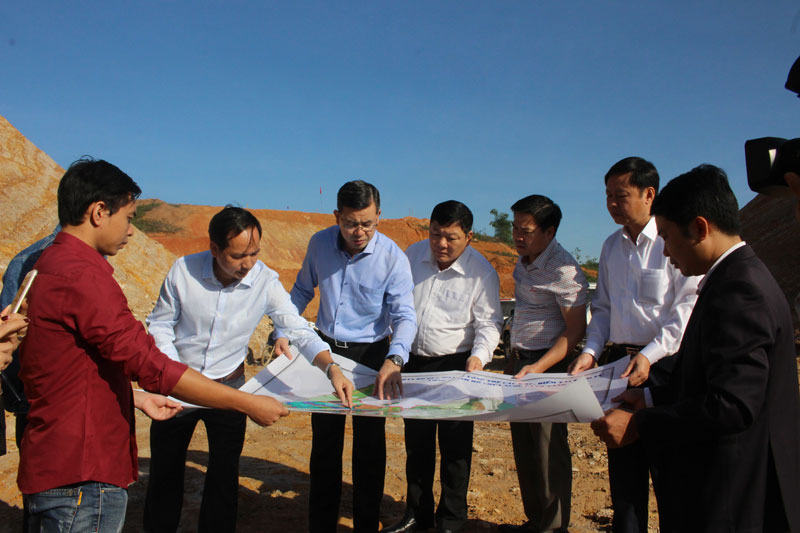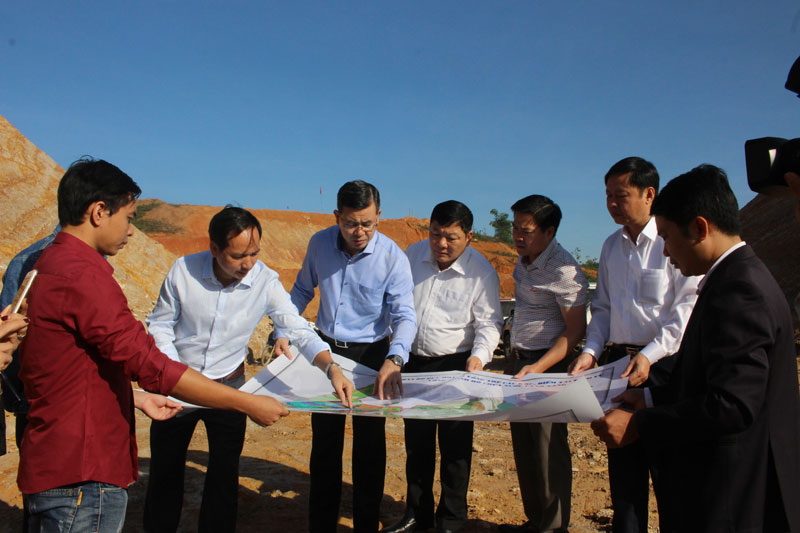
(HBO) – Vice Secretary of the Hoa Binh provincial Party Committee Ngo Van Tuan on October 30 had a working session with the Standing Board of the Party Committee of Lac Son district to review the performance in the first nine months of 2019 and mapped out major tasks and solutions for the remaining months. The meeting also reviewed the implementation of the 26th district Party Congress’ Resolution for the term 2015 – 2020.
 Vice Secretary of the provincial Party
Committee Ngo Van Tuan inspects progress of Canh Tang reservoir project.
Vice Secretary of the provincial Party
Committee Ngo Van Tuan inspects progress of Canh Tang reservoir project.
In the first nine months of the year, Lac Son district
has seen growth in agriculture, industry and handicrafts, trade, and
services. The district has focused on building new-style rural areas, ensured
social welfare and social order – security, and accelerated land clearance at
major projects such as Canh Tang reservoir and the road from Ho Chi Minh
Highway and Highway
12B to Highway 1.
Over the past four years, Lac Son has met and even
surpassed 17 out of 18 goals set in the 26th district Party Congress’
Resolution. The local economy expanded 12 percent from the same period last
year, 32 percent of the communes have earned new-style rural area status
while the poverty rate dropped 6.1 percent.
Concluding
the session, Tuan hailed the district’s nine-month achievements
and the implementation of the 26th district Party Congress’ Resolution.
Regarding the key tasks in the remaining months, he asked for good
preparatory work for the next-term Party Congresses at all levels. He asked relevant
agencies to further promote public administrative reform and improve local
business climate.
He also urged greater efforts to preserve local
cultural identity, improve human resources quality, strengthen social order and
security, and improveplanning and management of land and environmental protection. He
requested the district to further boost economy, build new-style rural areas,
and sustainably reduce poverty.
The district must focus on developing its soil
map to effectively serve the development of agricultural and forestry, transformingproduction towards
chain value, strengtheningmanagement of forest protection,
developing timber plantations, and attracting more
strategic investors.
Ngo Van Tuan and his working delegation later paid a fact-finding
trip to Canh Tang reservoir
project and examine the farming of "cay doi,” a signature product of Chi Dao
commune./.
Hoa Binh province is undergoing a dynamic transformation amid Vietnam’s national digital transition. Building on Poliburo’s Resolution No. 57-NQ/TW on breakthroughs in science, technology, innovation, and national digital transformation, the province has rolled out a wide range of practical action plans. A standout initiative is the "Digital Literacy for All” movement, an effort to ensure that no one is left behind in the digital era.
Hoa Binh province is undergoing a dynamic transformation in the wake of the national digital transformation movement. Building on Resolution No. 57-NQ/TW of the Politburo on breakthroughs in science, technology, innovation, and national digital transformation, the province has implemented a wide range of practical action plans. A standout initiative is the "Digital Literacy for All” movement ambitious effort to ensure that no one is left behind in the digital age.
With a spirit of unity and proactive problem-solving, the Party Committee, the government and the people of Dong Lai Commune (Tan Lac District) have made great strides in implementing the resolutions of the 24th Party Congress of the commune for the 2020 - 2025 term. Focusing on leadership and practical actions, the commune has brought the Party’s resolutions into daily life, creating strong impacts and pushing the local development forward.
Amid the nationwide push for digital transformation, young people in Hoa Binh Province are stepping up as dynamic pioneers, applying technology to enhance Youth Union operations and expand the reach of youth-led initiatives. Through creativity and adaptability, Youth Union organizations at all levels have introduced a series of practical solutions, contributing to modern governance and community development.
In recent years, An Nghia commune, located in Lac Son district, has stepped up administrative reform, focusing on improving the quality and efficiency of its single-window service unit for receiving and processing administrative procedures. These improvements have helped create favourable conditions for local residents and organisations to handle administrative procedures, contributing to the commune’s broader socio-economic development.
The Prime Minister-approved master plan to develop the multi-use value of forests ecosystems through 2030, with a vision to 2050, aims to improve the management and sustainable use of forest resources, create jobs, increase incomes, and improve the living standards of ethnic minorities, people in mountainous and remote areas, forest workers and those living near forests.



 Vice Secretary of the provincial Party
Committee Ngo Van Tuan inspects progress of Canh Tang reservoir project.
Vice Secretary of the provincial Party
Committee Ngo Van Tuan inspects progress of Canh Tang reservoir project.